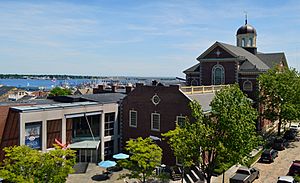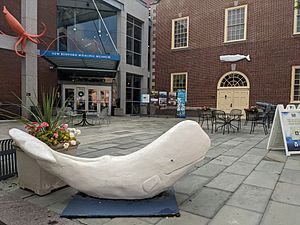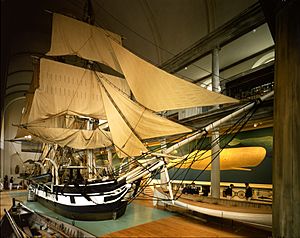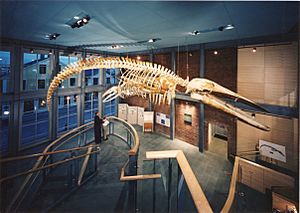New Bedford Whaling Museum facts for kids
 |
|

New Bedford Whaling Museum and New Bedford Harbor
|
|
| Lua error in Module:Location_map at line 420: attempt to index field 'wikibase' (a nil value). | |
| Established | 1903 |
|---|---|
| Location | 18 Johnny Cake Hill, New Bedford, Massachusetts |
| Collection size | 750,000 items |
The New Bedford Whaling Museum is a cool place in New Bedford, Massachusetts, USA. It teaches visitors all about the history of the whaling industry. Whaling was when people hunted whales for their oil and other products.
The museum also explores the history of the local area, once called Old Dartmouth. This area now includes New Bedford and nearby towns like Acushnet, Dartmouth, Fairhaven, and Westport.
The Old Dartmouth Historical Society (ODHS) runs the museum. This group started in 1903 to help people learn about Old Dartmouth's past. Today, the museum also talks about big global topics. These include how using too many natural resources affects the Earth. It also shows how industries change and how to be accepting of people from different backgrounds.
The museum has a huge collection of over 750,000 items! This includes 3,000 pieces of scrimshaw. Scrimshaw is art made by sailors from whalebone or teeth. It also has 2,500 logbooks from whaling ships. These are like diaries kept by sailors. Both of these collections are the biggest in the world! You can also see five complete whale skeletons here. The museum is made up of many buildings with 20 exhibit rooms. It takes up a whole city block inside the New Bedford Whaling National Historical Park.
The museum also displays amazing fine art. These artworks are by famous American artists who lived or worked in the New Bedford area. Some of these artists include Albert Bierstadt, William Bradford, and Albert Pinkham Ryder. There's also a collection of local decorative art, glass, and furniture. These items show how New Bedford grew as a whaling port in the 1800s.
One special part of the museum is the Bourne Building. It holds the Lagoda. This is a half-scale model of a whaling ship. It was built in 1916 and is the largest model whaling ship in the world!
Contents
How the Museum Started
The idea for the museum began on January 7, 1903. A news reporter named Ellis L. Howland suggested starting a historical society and a museum. He felt it was very important to save the history of New Bedford. He worried that old ship logbooks were being lost or destroyed.
On July 22, 1903, about 100 people started the Old Dartmouth Historical Society. They chose William W. Crapo, a local lawyer, as their first president. At first, the museum rented rooms to show its artifacts. By 1904, almost 700 people had joined. The museum's collection grew to about 560 items.
In 1906, a generous person named Henry Huttleston Rogers gave the Old Dartmouth Historical Society a building. This building, the Bank of Commerce Building, was on Water Street. One year later, in 1907, the New Bedford Whaling Museum officially opened its doors.
The museum grew a lot in the 1910s and 1920s. In 1914, Frank Wood became the first full-time staff member as the curator. A curator is someone who takes care of a museum's collections. In 1915, Emily Bourne donated the Bourne Building. She did this to honor her father, Jonathan Bourne Jr.. She also gave money to build the half-sized model of her father's ship, the Lagoda. This model was built inside the Bourne Building in 1916.
Interest in whaling history grew even more because of a 1922 movie. The film, Down to the Sea in Ships, was filmed in New Bedford. Many local people dressed up in old clothes and acted as extras.
By the 1930s, the museum was very popular. It attracted thousands of visitors each year. The museum expanded again in 1935 with the Wood Building. In 1936, the museum got its first whale skeleton. It was a three-year-old humpback whale named Quasimodo. The curator, William Tripp, was very happy. He said, "We are no longer a whaling museum without a whale!"
In 1953, another whaling movie, All the Brothers Were Valiant, premiered in New Bedford.
During the 1970s, the anti-whaling movement grew. This led a museum curator, John R. Bockstoce, to study and collect information on the bowhead whale. His work showed how important it was to save historical whaling documents.
In 1996, the museum helped create the New Bedford Whaling National Historic Park. This national park includes several historical spots in New Bedford. One of them is the Seamen's Bethel, which is right across from the museum. The museum also shows a short film called The City that Lit the World. Also in 1996, the museum held its first annual Moby-Dick Marathon Reading. This is where people read the entire famous book aloud.
In 1998, the museum worked with the Azorean Maritime Heritage Society. They built the Azorean Whaleman Gallery. This exhibit shows how sailors from the Azores islands helped the US whaling industry. In August 2000, the Jacobs Family Gallery was built. The humpback whale skeleton, Quasimodo, was moved there. A new skeleton of a young blue whale, named KOBO, was hung next to it.
In 2001, the museum started talks to join with the Kendall Whaling Museum. The Kendall Whaling Museum had opened in 1956. The two museums officially merged in October 2001. By November 2002, the Kendall Museum's artifacts were moved to New Bedford. This added about 70,000 items to the collection, almost doubling its size! To hold all these new items, the museum bought an old bank building. This building housed the museum's Research Library for several years. In 2017, the library moved to a new building on the main museum campus.
In 2002, the New Bedford Whaling Museum also partnered with the Melville Society. Now, the museum's Research Library holds their large collection of items related to the author Herman Melville.
The museum continued to add to its whale skeleton collection. In 2002, it got a sperm whale skeleton. In 2008, it acquired the skeleton of a North Atlantic right whale. This whale was pregnant when it died.
In 2012, the Whaling Museum was featured on the TV show Four Weddings on TLC. One of the brides had her wedding reception there!
What You Can See: Permanent Exhibits
The Lagoda Ship Model
The museum's Jonathan Bourne Building is home to the Lagoda. This is a half-scale model of the ship Lagoda, which was owned by Jonathan Bourne Jr. The model was built in 1916. The Lagoda model is 89 feet (27 meters) long. Its mainmast is 50 feet (15 meters) tall. This makes it the largest model whaling ship in the world! It has all its ropes and sails, showing what a real whaling ship looked like. It also displays some of the supplies needed for a long whaling trip.
Azorean Whaleman Gallery
The Bourne Building also has a special exhibit about the Azores islands. It shows how people from the Azores helped New England grow, especially New Bedford. New Bedford has a large and lively community of Portuguese Americans from the Azores. The exhibit has many items related to whaling in the Azores. It also tells the story of how islanders traveled to the US on "whale ships" to start new lives. You can see a half-scale model of an Azorean whaleboat. There's also a vigia, which was an Azorean whaling lookout tower.
Skeletons of the Deep
The museum has five complete whale skeletons! These include a blue whale, a humpback whale, a sperm whale, and a mother North Atlantic right whale with her baby. All these whales died naturally or from accidents. They were not killed by whaling.
The first skeleton the museum got was a 37-foot (11-meter) humpback whale. It was three years old and named Quasimodo. It died in 1932. The blue whale skeleton is 66 feet (20 meters) long. It is a young male named KOBO (King of the Blue Ocean). The sperm whale skeleton is 48 feet (15 meters) long and was about 30 years old. The right whales are a 49-foot (15-meter) female named Reyna. She was 15 years old and ten months pregnant when she died. Her fetus's skeleton is also displayed.
Harbor Hope in Old Dartmouth: 1602–1827
This exhibit explores the history of the Old Dartmouth region. It starts from when English explorer Bartholomew Gosnold landed there in 1602. It continues to when New Bedford became the most important city in the whaling industry. The exhibit looks at how religion, geography, and sea trade helped this area grow. These factors led to New Bedford becoming the biggest whaling center in the US around 1827. It even became bigger than Nantucket!
See also




